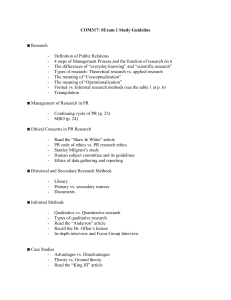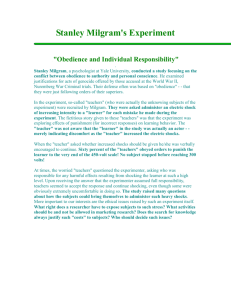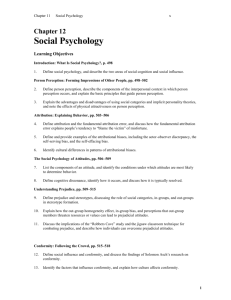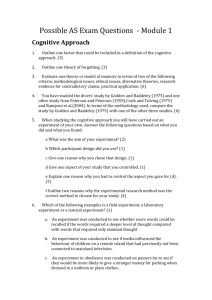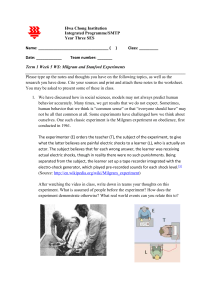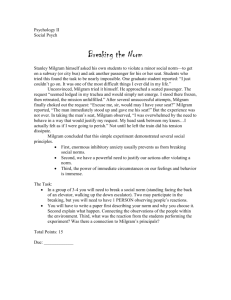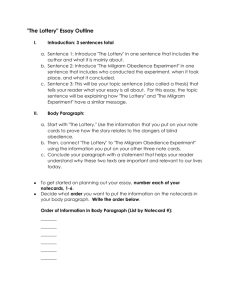File
advertisement
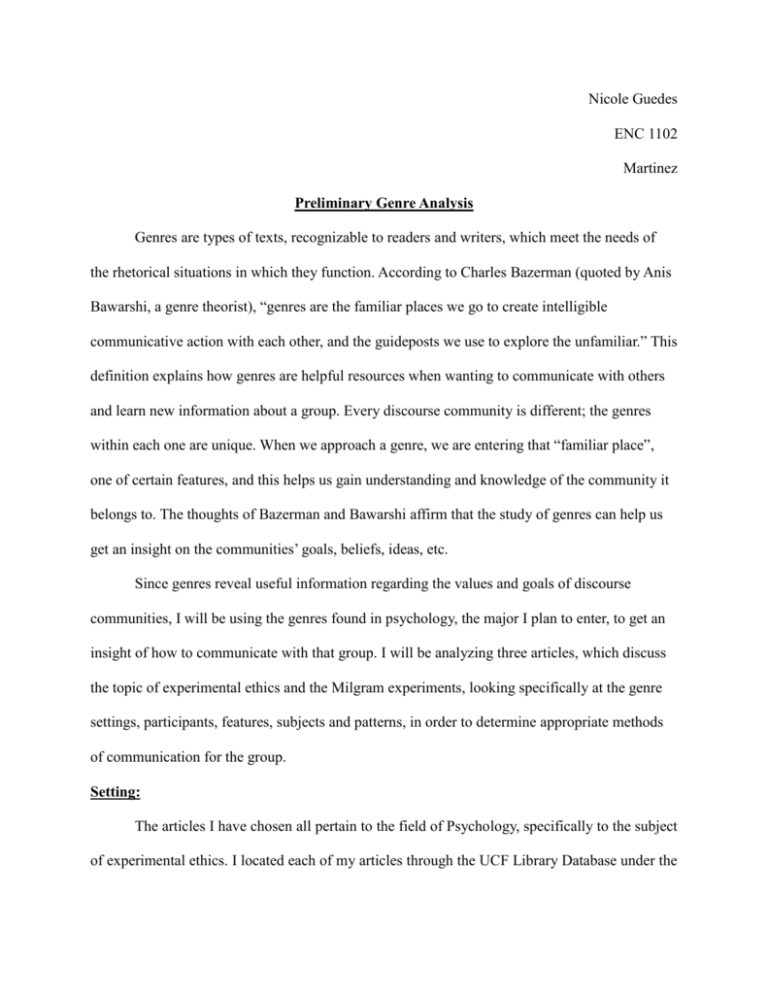
Nicole Guedes ENC 1102 Martinez Preliminary Genre Analysis Genres are types of texts, recognizable to readers and writers, which meet the needs of the rhetorical situations in which they function. According to Charles Bazerman (quoted by Anis Bawarshi, a genre theorist), “genres are the familiar places we go to create intelligible communicative action with each other, and the guideposts we use to explore the unfamiliar.” This definition explains how genres are helpful resources when wanting to communicate with others and learn new information about a group. Every discourse community is different; the genres within each one are unique. When we approach a genre, we are entering that “familiar place”, one of certain features, and this helps us gain understanding and knowledge of the community it belongs to. The thoughts of Bazerman and Bawarshi affirm that the study of genres can help us get an insight on the communities’ goals, beliefs, ideas, etc. Since genres reveal useful information regarding the values and goals of discourse communities, I will be using the genres found in psychology, the major I plan to enter, to get an insight of how to communicate with that group. I will be analyzing three articles, which discuss the topic of experimental ethics and the Milgram experiments, looking specifically at the genre settings, participants, features, subjects and patterns, in order to determine appropriate methods of communication for the group. Setting: The articles I have chosen all pertain to the field of Psychology, specifically to the subject of experimental ethics. I located each of my articles through the UCF Library Database under the psychology section. This led me to a series of basic databases, from which I chose PsycInfo (EBSCOhost), which contains materials from more than 1,300 journals covering scholarly literature in all aspects of psychology and related fields (1887-current). I accessed the articles by using the keywords “Milgram experiments” and “experimental ethics” and then chose the three articles from the results given. Participants: Writers of this genre range from psychologists to university professors. The author of my first article “Sciences, Fallacies and Ethics”, Lewis W. Brandt, worked in the University of Saskatchewan Regina Campus, and has written several journals on different subjects within psychology such as phenomenology, psychoanalysis and behaviorism. H. Kaufmann, the author of my second article “The Price of Obedience and the Price of Knowledge”, was a psychology professor in the University of Toronto and has written works ranging from psychiatry to neurology. Ian Freckelton SC, the author of the third article, a book review of “Behind the Shock Machine: the Untold Story of the Notorious Milgram Psychology Experiments, by Gina Perry”, is a full-time practicing barrister and a part-time professor of law, forensic psychology and forensic medicine in the Monash University in Australia, who has received various grants and awards in relation to his research. Each of the authors is well respected within their own field for the amount of research and effort they have put into their works, establishing their knowledge and credibility. These articles are typically read by people involved in the study of social sciences. “Milgram's experiments have been the subject of extensive and divisive debate amongst psychologists, sociologists and ethicists” (Book Review—“Behind the Shock Machine: the Untold Story of the Notorious Milgram Psychology Experiments”). From this statement we can infer that a wide range of scientists may be interested in this topic and these articles. Readers should have some background knowledge of the Milgram experiments or should at least have an interest in the controversies of experimental ethics. Subject: The three articles discuss the topic of experimental ethics, particularly those of the Milgram experiments on obedience to authority figures (a series of experiments which measured the willingness of study participants to obey an authority figure who instructed them to perform acts that conflicted with their personal conscience). They all analyze the Milgram experiments, describing the procedures and results, while maintaining present the question of ethic and deception of man. “How much discomfort is it legitimate to inflict?” (“The Price of Obedience and the Price of Knowledge”) was one main issue relevant to ethics which each of the articles addressed. More specifically, Brandt addresses this issue by creating some ethical guidelines, explaining in great detail the principles of which the experimenters and subjects should act if choosing to work with human subjects. The authors also target the controversy that was created with these experiments; since using human subjects a discussion of legitimacy emerged arguing whether ethics were being followed. Brandt responds to this discussion by stating that “experiments with human subjects are shown to be undemocratic and unnecessary,” meaning that there are certain experiments where the subject’s behavior can be predicted from the experimenter’s behavior, and he continues by asserting that “psychological experiments with human subjects are frequently based on faulty assumptions which may lead not only to erroneous conclusions but also to warped ethics.” Kaufmann and Freckelton also agree on Brandt’s assumption that whenever humans are involved “warped ethics” will always be a problem. Since this is such a controversial topic, there is a battle of whether these experiments are actually beneficial in learning new information or if we disregard them because they are deemed unethical. Kaufmann states: “The social theory of evil may be distressing and humiliating to the stature of man, but then, learning to know oneself is seldom a gratifying experience, yet one which few of us would forgo.” He is referring to the costs and benefits of these experiments, whether we just succumb to the “evil” that is performed or let ourselves overcome it and gain new knowledge. Features: Although the lengths of the three articles vary, they each present the information the same way. In an essay format, the authors all start out by introducing the Milgram experiments: explaining what they are, the procedures and the results. Already having given the reader the basic information on the topic, the articles then begin to touch upon the controversies these experiments have created and their ethical dilemmas. We notice that each author only uses factual information, constantly referencing Milgram's works, and avoiding including any type of opinion. For example, Kaufmann (author of “The Price of Obedience and the Price of Knowledge”) incessantly writes “according to Milgram” or “referring to Milgram’s experiments” which affirms that what Kaufmann is saying is indeed fact. This helps to objectify the articles, allowing the reader to learn the facts, and letting him form his own assessment. The language in these articles is pretty basic; some special jargon is used (like when mentioning “contra hominem” in Brandt’s and Kaufmann’s articles), but overall the articles are accessible for anyone to read and understand. Aside from referencing Milgram's works, the authors also refer to works others have written on the same subject (Kaufmann, the author of one of my articles “The Price of Obedience and the Price of Knowledge” is referenced in my other article “Science, Fallacies and Ethics”), and this just helps to provide more details and information for the reader. We can also notice, when referring to the topic of controversial ethic, the authors always include both sides of the argument, again, to present more information to the reader. At the end, a works cited list is common to the articles, where all the sources used are presented. Patterns: From the features I have discussed, I can conclude that, within this genre, objective information is imperative, as is providing details from various viewpoints. This delivers a wide range of information to the reader, which seems to be the main goal of the genre. The common informative tone helps the reader understand the topic, and by being presented with different arguments and questions, the reader himself can form an opinion. Also, by approaching the content of the articles in an unbiased manner, the authors help make their work more credible. The patterns in this genre simply revolve around the goal of making the reader more knowledgeable of the facts. The authors basically try to turn a controversial topic into a neutral set of information, letting the reader use and interpret the information anyway he wishes. References: Brandt, L. W. (1971). Science, fallacies and ethics. The Canadian Psychologist, 12(2), 231-242. Kaufmann, H. (1967). The price of obedience and the price of knowledge. American Psychologist, 22(4), 321-322. Freckelton, I. (2012). Book review- "Behind the Shock Machine: the Untold Story of the Notorious Milgram Psychology Experiments, by Gina Perry". Psychiatry, Psychology and Law, 19(3), 448-450.
